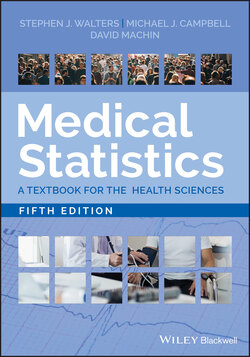Читать книгу Medical Statistics - David Machin - Страница 51
Example – Calculation of the Range, Quartiles, and Inter‐Quartile Range – Corn Size Data
ОглавлениеSuppose, as in Table 2.5, we had the 16 corn sizes in millimetres arranged in increasing order (from smallest to largest) from the Farndon et al. (2013) study. The median is the average of the eighth and ninth ordered observations (3 + 3)/2 = 3 mm. The first or bottom or lower half of the data has eight observations; so the cut‐point for the first or lower quartile is the observation that splits the eight lowest ranked observations into two halves again, that is, four observations in each ‘half’. Thus, the lower quartile lies somewhere between the fourth and fifth ordered observations. When the quartile lies between two observations the easiest option is to take the mean of the two observations (although there are more complicated methods). So the lower quartile is (2 + 2)/2 = 2 mm.
Similarly, the upper quartile is calculated from the top half of the data (i.e. the observations with the largest values). The second or top or upper half of the data has eight observations; so again the cut‐point for the upper quartile is the observation that splits the eight highest ranked observations (ordered observations 9–16 into two halves again, (i.e. four observations in each ‘half’). Thus, the upper quartile lies somewhere between the 12th and 13th ordered observations. Since the quartile lies between two observations the easiest option is to take the mean of the two observations. Therefore, the upper quartile is (4 + 5)/2 = 4.5 mm. So, the interquartile range (IQR), for the corn size data, is from 2.0 to 4.5 mm; or a single number 2.5 mm.
